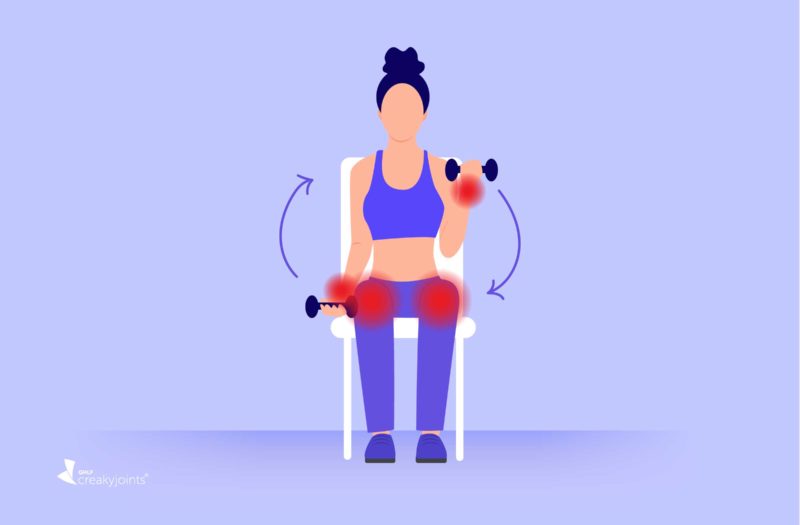Learn more about our FREE COVID-19 Patient Support Program for chronic illness patients and their loved ones.
Key Takeaways
- The COVID-19 pandemic has affected people’s physical activity levels, particularly those with rheumatic and musculoskeletal diseases (RMDs).
- A new study presented at ACR Convergence 2021 found that more than half of people with RMDs did not meeting their exercise goals during the COVID-19 pandemic.
- Many participants said they lacked motivation and and were worried about contracting COVID-19 if exercising outside their home.
Have you been exercising more, less, or in different ways during the COVID-19 pandemic? It would likely surprise few to learn that the COVID-19 pandemic has affected people’s physical activity levels, but new research shows the extent of the perceived impact for patients with rheumatic and musculoskeletal diseases (RMDs).
People with certain rheumatic conditions may have different experiences with physical activity during the pandemic than the general population for many reasons, such as living with chronic pain or trying to stay home as much as possible because of their immunocompromised status.
In a new study presented at ACR Convergence 2021, the annual meeting of the American College of Rheumatology, researchers identified a sample of 7,776 adult patients with RMDs through an academic healthcare system in North Carolina. These patients received invitations to participate in an online survey between July and September of 2020 to assess self-reported changes in physical activity during the COVID-19 pandemic, barriers to physical activity, and health and well-being.
Of the initial sample, a total of 1,133 participants completed the survey. Over half of the participants (55.5 percent) reported that they engaged in less physical activity since the start of the pandemic. Factors associated with less reported physical activity included male sex, lower income during the COVID-19 pandemic, poorer self-reported health status, self-reported lupus (SLE) diagnosis, and self-reported comorbid chronic pain, depression, and hypertension.
The average age was 57 years and 75 percent of respondents were female.
“It was eye-opening to see how the COVID-19 pandemic has affected so many people’s physical activity, especially patients with lupus,” says Teresa Dickson, the lead author of the study and Clinical Research Coordinator on the research team of Dr. Saira Sheikh at the University of North Carolina at Chapel Hill, Thurston Arthritis Research Center. “This study showed a diagnosis of SLE was associated with lower self-reported physical activity.”
Most participants (67 percent) reported not meeting their exercise goals during the COVID-19 pandemic. The most common reported barriers to physical activity included increased overall fear and anxiety (33.5 percent), lack of motivation (33 percent), and fear of contracting COVID-19 specifically (32 percent).
Researchers anticipated that closures of public exercise facilities and parks would impact physical activity among patients with rheumatic disease — and they expected to see the associations with decreased physical activity among patients with depression, since previous studies have shown associations between depression and physical activity, says Dickson. The researchers also weren’t surprised that people who reported poor overall health participated in less physical activity.
“Widespread barriers to physical activity were reported in our study and are likely to continue impacting individuals beyond the COVID-19 pandemic,” says Dickson. “Lack of motivation was a barrier prior to the pandemic, exacerbated by the pandemic, and will likely remain a barrier to physical activity beyond the pandemic unless it is addressed head-on with tailored interventions.”
Although many barriers to physical activity still exist, there is hope that the COVID-19 vaccines will play a role in reducing at least one of them.
“We are optimistic that with widespread availability of the COVID-19 vaccine, the fear and anxiety of contracting the coronavirus infection will decrease,” says Dickson.
As with all research, there are limitations of this study: The generalizability of these results may be limited by the single health care system and lack of geographic variability. Online survey distribution may have also restricted participation for those with limited access to the internet, and there was a low rate of responses among the Spanish-speaking population.
However, the research does shed light on the common barriers to physical activity that patients with rheumatic and musculoskeletal diseases face.
“If you are struggling with motivation, we encourage you to find an accountability partner, such as a friend, neighbor, family member, or significant other,” says Dickson. “An accountability partner can provide moral support as well as help meet physical activity goals. If fear or anxiety is a barrier to exercising, we recommend finding safe ways to participate in physical activity such as exercising outdoors, trying an online exercise class, or dancing to music.”
Get Free Coronavirus Support for Chronic Illness Patients
Join the Global Healthy Living Foundation’s free COVID-19 Support Program for chronic illness patients and their families. We will be providing updated information, community support, and other resources tailored specifically to your health and safety.






